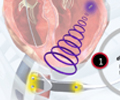
Introduction
The evolution of the remote monitoring of cardiovascular implantable electronic devices (CIEDs) in the last 10 years has seen a paradigm shift in technology, from the original analogue phone remote monitors with their induction loop headers, to the radio frequency (RF) devices we often see in use today, which require little patient interaction and can be remotely scheduled by the device clinic. Furthermore, modern devices perform routine tests assessing device function automatically, such that patients only require in-hospital visits for re-programming. Within the next couple of years, with the advent of Bluetooth technology, the capacity for CIEDs to communicate directly with the patient’s smart phone, and, using this as a hub, to send real-time information to the device clinic, has the potential to further transform the follow-up of cardiac device patients.
Our practice
The Great Western Hospital, Swindon (GWH), were early adopters of remote monitoring for cardiac device patients, registering our first patients back in 2009. Remote monitoring has been offered to all patients, with compatible devices, since 2011. There are currently nearly 3,000 patients in our device population of 6,000, who are actively followed up remotely. The remote monitoring service runs seven days a week, with clinics performed on weekdays and alerts checked on weekends. Between 2011 and 2016 our remote monitoring team performed over 18,000 remote device follow-ups.
Remote follow-up requires the use of automatic threshold testing algorithms and is only offered to cardiologically stable patients. The department has developed standardised pacemaker, implantable cardioverter defibrillator (ICD) and cardiac resynchronisation therapy (CRT) programming post-implant. Physiologists are trained and experienced enough to know how to respond to abnormal parameters detected via remote follow-up. Patients with advanced devices, ICD, CRT and the growing population of permanent His-bundle pacing (PHBP) patients, are seen once a year in device clinic and followed up remotely at six month intervals. GWH have shown remote device follow-up to be safe and report zero adverse events within our completely remote follow-up patients within our pacing population. Achieving remote follow-up ideally requires paperless working as a prerequisite, and portable document format (pdf) downloads are saved to Philips CVIS reports. Fysicon has a paperless in-clinic solution, which also automatically populates data from devices into a database, which avoids the error-prone duplication of data entry onto databases.
Remote monitoring is provided to patients immediately post-implant. Device patients are usually discharged the same day post-procedure, and this early distribution of remote monitoring allows the team to assess lead displacements and device function in the initial, more vulnerable, first weeks post-implant. Patient education plays a vital role in this service, as we are not envisaging physically seeing patients in clinic. Patients are educated post-implant as to symptoms that may indicate a device failure, the onset of heart failure and wound care. Patients are given a departmental authored information leaflet which they are to keep, to remind them of what has been discussed post-implant, and at their two-week post-implant pacing check. ICD patients are also given a fridge magnet to remind them of the procedures if they receive device therapy.
The remote monitoring service is staffed by a core team of six physiologists, with a diverse level of experience employed across Agenda for Change banding 6, 7 and 8a. Each of the members of the remote monitoring team has an interest in cardiac rhythm management and each holds a postgraduate qualification in devices. Interestingly, with the current national shortage of qualified cardiac physiologists/scientists, the ability to offer staff the benefits of more flexible working patterns when performing remote clinics has aided the department with both recruitment and retention of experienced and talented staff.
Management of alerts
One of the largest issues to be faced when running a remote follow-up service is the management of alerts. Alerts can be labour intensive. The cautious nature of the device, in reporting when a certain parameter or measurement may fall slightly outside of a pre-set normal range, forces the staff member checking the device alerts to often investigate an alert that has either been dealt with, or is classed as ‘normal’ for this patient or device. In the year April 2017 to the end of March 2018, the team at GWH reported upon over 11,500 device alerts.
With 10 years’ experience of the remote follow-up of CIEDs, the management of alerts has proven to be the most challenging aspect of this area. Many devices now allow the individual programming of alerts, but the programming of alerts should be considered similar to the programming of devices in line with the implant indication; one size certainly does not fit all. For example, patients with known atrial fibrillation (AF), who are adequately anticoagulated and rate controlled, should have AF burden alerts switched off. However, alerts for high ventricular rates during AF are still of use and an important heart failure diagnostic. Alert management is particularly important in the remote follow-up of implantable loop recorders (ILRs). An audit performed by one of the team at GWH proposed new programming guidance for ILRs, alerting the remote monitoring team only to episodes which are likely to require the intervention of the medical team; this change reduced the alert burden from ILRs alone by 85%.
Other issues
Other issues that can affect the remote follow-up of CIED patients, include the use of the technology itself. The set-up and operation of the remote monitoring device requires a degree of technical nous, with the mean age of the remote monitored patients at GWH being 74.4 ± 13.9 years. The majority of our patients have no issue with the set-up and maintenance of the remote monitoring device, while a degree of trepidation exists among a small number of patients who have never been exposed to such advanced technologies in the home setting.
A remote monitoring CIED service allows us to follow up patients seven days a week, in keeping with the NHS plan for seven-day services. However, other areas of the health service network may not have evolved to cope with admission of patients to hospital, who have remotely detected ICD therapy or sudden device failure.
The reluctance to offer remote follow-up exists within the cardiac physiology community centres around the inability to assess the patient for evidence of heart failure (HF) remotely. However, the European Society of Cardiology (ESC) Guidelines 20161 on the detection and management of HF state that symptoms are often non-specific and difficult to reproduce. CIEDs give us an enormous and continuous amount of diagnostic data, including information on patient activity, ectopic burden, thoracic impedance and heart rate variability. On their own these measurements may not mean very much, but allied together there is the potential to avoid HF events and hospital admissions by identifying these physiological changes and making early medical interventions on these patients. At GWH we have, within the last few months, started to analyse these alerts in more depth, and have established a pathway of referral to our community heart failure team to investigate and treat patients where the physiological data received may indicate fluid overload. Several industry-sponsored studies are currently investigating simplifying these data into a single HF remote alert.
Conclusion
Remote monitoring has dramatically reduced the in-clinic follow-up burden for patients at GWH, ensuring patients are followed up to a timeline in keeping with national guidance and best practice. It has allowed us to offer a seven-day service, which improves working patterns for our cardiac physiology staff and helps with recruitment and retention of staff at a time of national shortage. Remote monitoring offers patients, what we believe to be, the best possible care for their CIED, by giving them the peace of mind that they are being continually monitored, with proactive intervention should any concerns arise.
Key messages
- Remote monitoring of cardiovacular implantable electronic devices (CIEDs) represents a paradigm shift in technology
- It has dramatically reduced the in-clinic follow-up burden in our district general hospital
- It allows for a seven-day service, and improves working patterns for cardiac physiology staff and helps with staff recruitment and retention
- It offers patients the best possible care and provides peace of mind
Conflict of interest
None declared.
Articles in this supplement:
Introduction
Current and future perspectives on cardiac pacing
A brief history of cardiac pacing in the UK
Cardiac resynchronisation therapy – developments in heart failure management
Drugs with devices in the management of heart failure
His-bundle pacing: UK experience and HOPE for the future!
Leadless pacing
Techniques in pacemaker and defibrillator lead extraction
Remote monitoring
Reference
1. Ponikowski P, Voors AA, Anker SD et al. 2016 ESC Guidelines for the diagnosis and treatment of acute and chronic heart failure: The Task Force for the diagnosis and treatment of acute and chronic heart failure of the European Society of Cardiology (ESC). Developed with the special contribution of the Heart Failure Association (HFA) of the ESC. Eur Heart J 2016;37:2129–200. https://doi.org/10.1093/eurheartj/ehw128

